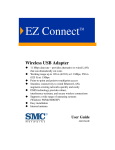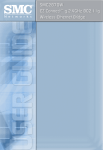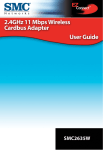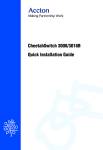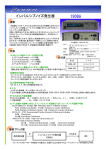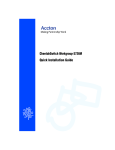Download Accton Technology Cheetah Wireless-3501C Installation guide
Transcript
Cheetah Wireless-3501C USB Adapter Quick Installation Guide Quick Installation Guide Cheetah Wireless-3501C USB Adapter 11 Mbps Wireless USB Adapter Copyright © 2003 by Accton Technology Corporation. All rights reserved. No part of this document may be copied or reproduced in any form or by any means without the prior written consent of Accton Technology Corporation. Accton makes no warranties with respect to this documentation and disclaims any implied warranties of merchantability, quality, or fitness for any particular purpose. The information in this document is subject to change without notice. Accton reserves the right to make revisions to this publication without obligation to notify any person or entity of any such changes. International Headquarters No. 1 Creation Road III, Science-based Industrial Park Hsinchu 300, Taiwan, R.O.C. Phone: +886-3-5770-270 Fax: +886-3-5770-267 Internet: [email protected] Europe Headquarters Edificio Conata II, Calle Fructuós Gelabert 6-8, 2o, 4a, 08970 - Sant Joan Despí, Barcelona, Spain. Phone: +34-93-477-4920 Fax: +34-93-477-3774 Asia Pacific Headquarters 1 Claymore Drive #08-05/06 Orchard Towers (Rear Block) Singapore 229594 Phone: +65 238 6556 Fax: +65 238 6466 Internet: www.acctontech.com Accton is a trademark of Accton Technology Corporation. Other trademarks or brand names mentioned herein are trademarks or registered trademarks of their respective companies. WN3501C F1.0 E052003-R01 Contents Introduction System Requirements Package Checklist Applications 1 1 1 2 Hardware Description LED Indicator Multi-choice Mounting Clip 3 3 3 Hardware Installation Attaching the Clip (Optional) Attaching the Magnets (Optional) Attaching the Velcro (Optional) Attaching the USB Cable 3 3 4 4 4 Driver Installation Windows 95/98/Me/2000 Driver Installation Setting Wireless Properties Windows XP Driver Installation 5 5 7 18 Configuration and Diagnostics Installing the Utility in Windows 95, 98, Me, and 2000 Using the Wireless USB Utility in Windows 95, 98, Me, 2000, and XP 21 21 Status Statistics Site Survey Encryption Advanced Version 21 22 23 24 25 26 27 i Contents Network Configuration and Planning Network Topologies Ad Hoc Wireless LAN Infrastructure Wireless LAN Setting the Communication Domain 28 28 28 29 30 Troubleshooting USB Adapter Installation Problems Network Connection Problems 31 31 31 Compliances Federal Communication Commission Interference Statement CSA Statement (Canada) VCCI Class B Compliance (Japan) CE Mark Declaration of Conformance for EMI and Safety (EEC) 33 33 34 34 34 Product Specifications General Specifications 36 36 Terminology 38 ii Introduction Accton’s Cheetah Wireless-3501C USB Adapter (WN3501C) is an 11 Mbps wireless network adapter that seamlessly integrates with existing Ethernet networks to support applications such as mobile users or temporary conferences. The adapter is fully compliant with 2.4 GHz DSSS CSMA/CA wireless networking as defined in IEEE 802.11b. This solution offers fast, reliable wireless connectivity with considerable cost savings over wired LANs (which include long-term maintenance overhead for cabling). Just plug wireless adapters into your desktop PCs and start networking. Using this adapter in conjunction with an Accton Cheetah Wireless Access Point or Wireless Access Point/Bridge, you can create an instant network that integrates seamlessly with 10 Mbps Ethernet LANs. Moreover, moving or expanding your network is as easy as moving or installing additional Wireless AP/Bridges – no wires! System Requirements Before you install the Cheetah Wireless-3501C USB Adapter, verify that your system meets the following requirements: • An available USB port • Windows 98/Me/2000/XP (have the Windows installation CD-ROM ready for use during driver installation) • A minimum of 1 MB of free disk space for installing the driver and utility program • Another IEEE 802.11b compliant device installed in your network, such as a Wireless Access Point, or another PC with a wireless adapter Package Checklist The Cheetah Wireless-3501C USB Adapter package includes: • 1 Cheetah Wireless-3501C USB Adapter with internal antenna (WN3501C) • 1 CD ROM containing drivers, utility, and documentation • 1 USB cable • 1 Fastening clip • 3 Pieces of velcro • 2 Magnets • This Quick Installation Guide • 1 registration card (please complete and return) Please complete the warranty registration card and return to Accton or register online at: register.acctontech.com. To order the optional boot ROM, contact your local Accton dealer or reseller. 1 Cheetah Wireless-3501C USB Adapter Please inform your dealer if there are any incorrect, missing or damaged parts. If possible, retain the carton, including the original packing materials. Use them again to repack the product if there is a need to return it for repair. Applications Cheetah Wireless products offer fast, reliable, cost-effective network access for wireless clients in applications such as: • Remote access to corporate network information E-mail, file transfer, and terminal emulation • Difficult-to-wire environments Historic or old buildings, asbestos installations, and open areas where wiring is difficult to employ • Frequently changing environments Retailers, manufacturers, and banks who frequently rearrange the workplace and change location • Temporary LANs for special projects or peak time Trade shows, exhibitions, and construction sites that need to setup for a short time period. Retailers, airline, and shipping companies who need additional workstations for peak periods. Auditors who require workgroups at customer sites • Access to databases for mobile workers Doctors, nurses, retailers, white-collar workers who need access to databases while being mobile in a hospital, retail store, office, campus etc. • SOHO users SOHO (Small Office Home Office) users who need quick and easy installation of a small computer network 2 Hardware Description Accton’s Cheetah Wireless-3501C USB Adapter supports an 11 Mbps half-duplex connection to Ethernet networks. This adapter is fully compliant with 2.4 GHz DSSS CSMA/CA wireless networking as defined in IEEE 802.11b. It can be installed in any notebook or desktop with a USB port. Support is provided for Windows 98/Me/2000/XP. LED Indicator The Cheetah Wireless-3501C USB Adapter includes an LED indicator, as described in the following table. Status Description On Power is being supplied to the adapter. Flashing Adapter is receiving or transmitting data via a wireless connection. Multi-choice Mounting Clip The WN3501C USB adapter is supplied with a multi-choice mounting clip. The clip may be slipped onto a belt or other convenient location. Magnets and velcro may also be attached to the clip for mounting in a variety of locations. Hardware Installation Attaching the Clip (Optional) 1. Slide the open end of the clip under the two lips (at the USB port end) in the square slot at the rear of the WN3501C. Lug Slots Lugs Lips 3 Cheetah Wireless-3501C USB Adapter 2. Press the two lugs into the slots until they click into place. 3. To remove the clip, push in one of the lugs and pull the clip away from the WN3501C body. The other lug should slip free. Attaching the Magnets (Optional) 1. Peel the protective paper off the magnets and place the sticky side of the magnets into the circular holes at the rear of the clip. 2. Press firmly. Warning: Sticking magnets to a notebook screen will damage the screen. Attaching the Velcro (Optional) 1. Peel the protective paper off the Velcro circles and firmly press the circles into the circular holes at the rear of the clip. 2. Temporarily hold the WN3501C in the desired location and check the signal quality is acceptable. Peel the protective paper off the Velcro strip and stick the strip in the chosen location. Attaching the USB Cable 1. Select an available USB port on the PC. 2. Carefully insert the USB cable’s Type-A plug (i.e., the flat plug) into the USB port and press until it is firmly seated in the port. Insert the other end of the cable into the WN3501C. Warning: 4 The plugs will only go into their respective slots one way. If the plugs do not comfortably enter the slots, turn them around and try again. Driver Installation The CD-ROM that comes with the package contains the software/drivers for the Cheetah Wireless-3501C USB Adapter. New or updated drivers can be downloaded from Accton’s web site at: http://www.acctontech.com. For installation in Windows 95/98/Me/2000 see the following section. For Window XP installations, please skip to “Windows XP Driver Installation” on page 22 for instructions. Windows 95/98/Me/2000 Driver Installation You may find that the instructions here do not exactly match your version of Windows. This is because these steps and screenshots were created from Windows 98. Windows 95, Windows Millennium Edition, and Windows 2000 are very similar, but not identical, to Windows 98. Note: Installation processes such as these usually require the use of your original, licensed copy of Windows. Please have your Windows CD on hand BEFORE proceeding with the installation. 1. Insert the Driver and Utility installation CD into the CD-ROM drive. 2. Plug the Cheetah Wireless-3501C USB Adapter into your PC’s USB port. 3. Windows OS will automatically prompt you to install the driver. 5 Cheetah Wireless-3501C USB Adapter 4. Click the Easy button for automatic installation, and then click Next. or Click on Advanced for Infrastruture or Ad Hoc network environments. SSID: The Service Set ID. This should be set to the same value as other wireless devices in your network. Channel: The radio channel through which the Cheetah Wireless-3501C USB Adapter communicates with PCs in its BSS. 6 Setting Wireless Properties 5. Click Next to copy files from the CD. Windows 98 may ask you for the Windows 98 CD. If so, remove the Cheetah Wireless-3501C USB Adapter CD, insert the Windows 98 CD and click OK. 6. Click Finish to complete the driver installation. You may be asked to restart the computer. Click Yes. Setting Wireless Properties 1. Click Start/Settings/Control Panel. Double-click the Network icon. 2. Click on the Identification tab in the Network dialog box and specify your computer name, network workgroup, and computer description. 7 Cheetah Wireless-3501C USB Adapter 3. If you want to add more protocols after installation, go to the Configuration tab and click Add. 4. Double-click Protocol and add the network protocols you wish to use. If you install TCP/IP, be sure to set the appropriate Gateway, DNS Server, and Domain for your network. If you install an IPX/SPX compatible protocol, then you also need to install the Client for NetWare Networks. 5. Click File and Print Sharing, and check the boxes as required. 6. On the Configuration tab, double-click the WN3501C adapter. 8 Setting Wireless Properties 7. On the Advanced tab you will find a list of properties. The 802.11 Power Save option allows you to enable the power saving mode for reducing power loading. 9 Cheetah Wireless-3501C USB Adapter 8. To communicate with Accton 11 Mbps Wireless devices, set the Authentication Type to Shared Key. Products from some other vendors may use the setting Open System. Use the same setting as the other devices in your network. 9. Select the basic communication rate from the drop-down list for your wireless PC card. 10 Setting Wireless Properties 10. The Beacon Period (20-1000 kµs) option allows the wireless devices to maintain contact with each other. The beacon signal may also carry power-management information. (Default: 100) 11 Cheetah Wireless-3501C USB Adapter 11. Set the Channel to the same radio channel as that used by the other wireless clients in your group. However, if you are connecting to a network via an access point, the adapter will automatically set the channel to the same as that used by the access point. 12 Setting Wireless Properties 12. Wired Equivalent Privacy (WEP) is implemented in the adapter to prevent unauthorized access. For more secure data transmissions, set encryption to 128-bit or 64-bit. The 128-bit setting gives a higher level of security. The setting must be the same for all clients in your wireless network. (Default: None) To completely configure WEP you must use the Configuration Utility. See “Encryption” on page 29. 13 Cheetah Wireless-3501C USB Adapter 13. Set the ESSID identifier to the same as that used by the ad hoc workgroup or access point to which you want to connect. (The Accton access point default is WLAN.) If you will be roaming among multiple access points with different BSS IDs, a value of ANY will allow connection to any ESSID. 14. Set the Fragmentation Threshold. (The default 2,346 means Disabled.) See “Terminology” on page 42 for a description of Fragmentation Threshold. 14 Setting Wireless Properties 15. Enable the International Roaming for mobile workers roaming in an infrastructure network. More than one access point may be configured with the same SSID to create an Extended Service Set (ESS). See “Roaming Wireless PCs” on page 34 for details. 15 Cheetah Wireless-3501C USB Adapter 16. Set the station operation mode to 802.11 Ad Hoc for network configurations that do not have an access point, or to Infrastructure for connecting to an access point. 16 Setting Wireless Properties 17. The access points and client card drivers have a radio setting for RF Preamble. Enabling it can boost your throughput. Preamble Type offers a drop-down list with three options: Auto, Long, or Short. If you are not sure whether all the clients and access point radios in your wireless network support the Short RF preamble, then leave this setting on Auto. See “Terminology” on page 42 17 Cheetah Wireless-3501C USB Adapter 18. Rate is the data transmission/reception rate setting. It can be set to Auto, 1 Mbps, 2 Mbps, 5.5 Mbps, or 11 Mbps. Usually this should be set to Auto. In a radio frequency hostile environment, a lower rate can provide more stable transmission quality. 18 Setting Wireless Properties 19. The access point sends Request to Send (RTS) frames to a particular receiving station to negotiate the sending of a data frame. After receiving an RTS frame, the station sends a CTS (Clear to Send) frame to acknowledge the right of the sending station to send data frames. The access points contending for the medium may not be aware of each other. The RTS/CTS mechanism can solve this “Hidden Node Problem.” Set the RTS Threshold to the same as that used by other devices in your network. (The default 2,347 means Disabled.) See “Terminology” on page 42 for a description of RTS Threshold. 19 Cheetah Wireless-3501C USB Adapter 20. The WEP encryption implemented in Accton’s Wireless USB adapter is based on the RC4 encryption algorithm. The security keys are four 10 digit keys for the 64-bit WEP setting, and one 26-digit key for the 128-bit WEP setting. WEP must be set in the configuration utility and all changes can be made there. (See “Using the Wireless USB Utility in Windows 95, 98, Me, 2000, and XP” on page 25.) 20 Setting Wireless Properties 21. “WEP Key to use” shows the key that will be used (WEP KEY #1~#4 as shown on the previous screen) for encryption. 22. Click OK to exit the open screens and click Yes to restart the computer if asked to do so. 21 Cheetah Wireless-3501C USB Adapter Windows XP Driver Installation 1. Insert the installation CD into your PC’s CD-ROM drive. 2. Plug the Cheetah Wireless-3501C USB Adapter into your PC’s USB port. 3. Windows XP will automatically detect the new hardware and prompt you to install the driver. 4. Check “Install from a list or specific location (Advanced)” and click Next. 22 Windows XP Driver Installation 5. Check “Don’t search. I will choose the driver to install” and click Next. 6. Click Have Disk, and the Install From Disk screen will open. 7. Type E:\driver\usb\setup (assuming your CD drive is E:) and click OK. 23 Cheetah Wireless-3501C USB Adapter 8. Though the software is fully compatible with Windows XP, it has not yet been Logo tested by Microsoft. On the Hardware Installation screen click Continue Anyway. 9. After the software has been installed, click Finish to complete the driver installation. 24 Configuration and Diagnostics For Windows 95, 98, Me, and 2000, Accton’s Cheetah Wireless-3501C USB Adapter provides optional management software for quick network configuration and easy diagnostics. Installing the Utility in Windows 95, 98, Me, and 2000 To install the utility software: 1. Insert the CD-ROM into your PC’s CD drive. 2. Click Start/Run 3. Type “E:\autorun.exe” (assuming your CD drive is E:) and click OK. 4. Follow the on-screen instructions to finish the installation. Using the Wireless USB Utility in Windows 95, 98, Me, 2000, and XP Once the installation is complete, the configuration utility can be accessed by selecting the Accton WN3501C WLAN USB Adapter Monitor icon from the Accton USB WLAN Utility folder. Also, a quick launch icon will appear in the lower right-hand corner of the task bar. If the icon is green, you have a good connection. If it shows red, you may need to place the access point in a higher position, or move closer to the access point you wish to connect to. Double-clicking the icon will open the WLAN USB Adapter Monitor program, providing quick access to the adapter settings. 25 Cheetah Wireless-3501C USB Adapter The configuration utility includes the following tools: Status – Allows you to monitor network status and configure wireless adapter parameters. Statistics – Shows wireless adapter statistics. Site Survey – Scans/Shows all the access points in range. Encryption – Provides WEP security control. Advanced – Allows you to configure the advanced settings. Version – Shows the version information. Status When you open the wireless USB utility, the information window for the WN3501C is shown as in the figure below. The Status page shows the network status of the wireless adapter. Profile Name – Enter a profile name and set up the connection parameters shown on the screen. Click Apply to save the profile. A Default profile is provided for hassle-free configuration. Operating Mode – Set the station operation mode to 802.11 Ad Hoc for network configurations that do not have an access point, or to Infrastructure for configurations with an access point. (Default: Infrastructure) 26 Using the Wireless USB Utility in Windows 95, 98, Me, 2000, and XP Channel – If you are setting up an ad hoc wireless LAN (see page 32), set the channel number to the same radio channel as that used by the other wireless clients in your group. However, if you are connecting to a network via an access point, then the channel is automatically set to the channel of the access point to which the adapter connects. Note: The Channel can only be set when the Operating Mode is 802.11 Ad Hoc. SSID – Input an SSID string for the wireless network to which you want to connect. (Default: ANY) If you will be roaming among multiple access points with different BSSIDs, a value of ANY will allow connection to any SSID. Tx Rate – Indicates the data transmission rate. Select an appropriate transmission speed. Lower speeds will give better range. See “Accton Networks 802.11b WN3501C Wireless USB Adapter Maximum Distance Table” on page 36. (Default: Fully Automatic) MAC Address – A unique MAC address of this USB network adapter Status – Shows the MAC address of the associated access point (BSS ID). Signal Strength – Shows the relative strength of the wireless connection to the access point. Link Quality – Shows the relative link quality (e.g., lack of frame errors) of the wireless connection to the access point. Statistics The Statistics screen displays Data and Management frames, and Rejected Packets. See “Terminology” on page 42 for a description of these terms. 27 Cheetah Wireless-3501C USB Adapter Site Survey The Site Survey screen displays all access points in the wireless LAN. You can choose one of them to connect to by double-clicking on an entry. 28 Using the Wireless USB Utility in Windows 95, 98, Me, 2000, and XP Encryption Encryption – Wired Equivalent Privacy (WEP) is implemented in the adapter to prevent unauthorized access. For more secure data transmissions, set encryption to 128-bit or 64-bit. The 128-bit setting gives a higher level of security. The setting must be the same for all clients in your wireless network. (Default: Disabled) The WEP encryption implemented in Accton’s Cheetah Wireless-3501C USB Adapter is based on the RC4 encryption algorithm. The security keys are four 10 digit keys for the 64-bit WEP setting, and one 26-digit key for the 128-bit WEP setting. Create with Passphrase – Security keys for WEP encryption are generated from a passphrase string, so you must use the same passphrase on all the other stations in your network. Manual Entry – Manual Entry allows you to manually enter key elements. Default Key ID – Choose the Key ID that has the encryption string you prefer. If you are using a key generated from a passphrase, you must use the same passphrase and key on each station. To use the WEP function, complete the following steps: 1. Select 128-bit or 64-bit in the Encryption field. 2. Check Create with Passphrase, type a string in the Passphrase field, and click Generate. 3. Select the key, and click Apply. 29 Cheetah Wireless-3501C USB Adapter Note: A Passphrase string can consist of up to 32 alphanumeric characters. Or 1. Check Manual Entry and enter hexadecimal numbers into one of the key fields. Each bit key must be in hexadecimal numerals (0~9, A~F, e.g., D7 0A 9C 7F E5). 2. Click Apply. Authentication Type – You may choose Open System, Shared Key or Auto. (Default: Shared Key) If Shared Key is enabled, one shared key should be defined in the Default Key ID. Advanced If you are not sure whether all the clients and access points in your wireless network support the Short RF preamble, then leave the setting of Preamble Type on Auto. You can use this screen to set values for Fragmentation Threshold (Default: 2346 means Disabled), and RTS/CTS Threshold (Default: 2347 means Disabled.) See “Terminology” on page 42 for a description of these terms. The Power Save mode enables the WN3501C to conserve battery power when there is no need to send data. 30 Using the Wireless USB Utility in Windows 95, 98, Me, 2000, and XP Version This screen displays the driver, firmware, and utility version numbers. 31 Network Configuration and Planning Accton’s Cheetah Wireless Solution supports a stand-alone wireless network configuration, as well as an integrated configuration with 10 Mbps Ethernet LANs. For a list of the maximum distances between the AP/Bridge and wireless clients, refer to page 36. The WN3501C USB adapter can be configured as: • Ad hoc – for small departmental or SOHO LANs • Infrastructure – for enterprise LANs Network Topologies Ad Hoc Wireless LAN An ad hoc wireless LAN consists of a group of computers, each equipped with a wireless adapter, connected via radio signals as an independent wireless LAN. Computers in a specific ad hoc wireless LAN must be configured to the same radio channel. An ad hoc wireless LAN can be used for a small branch office or SOHO operation. Ad Hoc Wireless LAN Notebook with Wireless USB Adapter Notebook with Wireless PC Card PC with Wireless PCI Adapter 32 Network Topologies Infrastructure Wireless LAN The WN3501C can also provide access to a wired LAN for wireless workstations. An integrated wired and wireless LAN is called an Infrastructure configuration. A Basic Service Set (BSS) consists of a group of wireless PC users, and an access point that is directly connected to the wired LAN. Each wireless PC in this BSS can talk to any computer in its wireless group via a radio link, or access other computers or network resources in the wired LAN infrastructure via the access point. The infrastructure configuration not only extends the accessibility of wireless PCs to the wired LAN, but also increases the effective wireless transmission range for wireless PCs by passing their signal through one or more access points. A wireless infrastructure can be used for access to a central database, or for connection between mobile workers. Wired LAN Extension to Wireless Adapters File Server Desktop PC Switch Notebook with Wireless USB Adapter Access Point PC with Wireless PC I Adapter 33 Cheetah Wireless-3501C USB Adapter Setting the Communication Domain Stationary Wireless PCs The Basic Service Set (BSS) is the communication domain for each access point. For wireless PCs that do not need to support roaming, set the domain identifier (SSID) for the wireless adapter to the BSS ID of the access point to which you want to connect. Check with your administrator for the BSS ID of the access point to which he wants you to connect. Roaming Wireless PCs An infrastructure network also supports roaming for mobile workers. More than one access point may be configured with the same SSID to create an Extended Service Set (ESS). By placing the access points so that a continuous coverage area is created, wireless users within this ESS can roam freely. All Accton Cheetah Wireless adapters and Cheetah Wireless Access Points within a specific ESS must be configured with the same SSID. Before setting up an ESS for roaming, choose a location for the access points that maximizes performance. (Refer to “Using the Wireless USB Utility in Windows 95, 98, Me, 2000, and XP” on page 25 for configuration information.) File Server Desktop PC Switch Notebook with Wireless PC Card Adapter Switch Access Point Notebook with Wireless USB Adapter Access Point <ESS> <BSS1> Seamless Roaming PC with Wireless PC I Adapter 34 <BSS2> Troubleshooting USB Adapter Installation Problems If your computer cannot find the Cheetah Wireless-3501C USB Adapter or the network driver does not install correctly, check the following items: • Make sure the adapter is connected to the USB port. • Try the adapter in another USB port. If this also fails, try using another WN3501C wireless adapter that is known to operate correctly. • Make sure your computer is using the latest BIOS. • If there are other network adapters in the computer, they may cause conflicts. Disable or remove the other adapters from the computer and test the wireless adapter separately. • Check for a defective computer or USB port by trying the adapter in another computer that is known to operate correctly. • If there are still difficulties, remove the wireless adapter. Delete the file “Vnetusbr.sys” from: c:\windows\system (in Windows 98/Me) c:\winnt\system32\drivers (in Windows 2000) c:\windows\system32\drivers (in Windows XP) Click “Start/Settings/Control Panel.” Delete the adapter from the network configuration menu. Restart the PC and reinstall the adapter. Network Connection Problems If the LED on the USB adapter is not lit, or if you cannot access network resources from the computer, check the following: • Make sure the correct software driver is installed. Try reinstalling the driver. • Make sure the computer and other network devices are receiving power. • The access point you want to connect to may not be functioning correctly. Try using another access point. • If you cannot access a Windows or NetWare service on the network, check that you have enabled and configured the service correctly. If you cannot connect to a particular server, be sure that you have access rights and a valid ID and password. • If you cannot access the Internet, be sure you have configured your system for TCP/IP. 35 Cheetah Wireless-3501C USB Adapter If your wireless station cannot communicate with a computer on the Ethernet LAN when configured for Infrastructure mode, check the following: • Make sure the access point that the station is associated with is powered on. • Check that the wireless settings (i.e., WEP, SSID, Channel) match the access point or other stations to which you are attempting to connect. • If you still cannot connect, change the access point and all the stations within the BSS to another radio channel. Accton Networks 802.11b WN3501C Wireless USB Adapter Maximum Distance Table Important Notice – Maximum distances posted below are actual tested distance thresholds. However, there are many variables such as barrier composition and construction, as well as local environmental interference that may impact your actual distances and cause you to experience distance thresholds far lower than those posted below. If you have any questions or comments regarding the features or performance of this product, or if you would like information regarding our full line of wireless products, visit us on the web at www.accton.com. Accton stands behind every product sold with a 30-day satisfaction guarantee and a limited-lifetime warranty. Accton 802.11b Wireless USB Adapter Maximum Distance Table Environmental Condition Outdoors: A line-of-sight environment with no interference or obstruction between the Access Point and users. Indoors: A typical office or home environment with floor to ceiling obstructions between the Access Point and users. 36 Speed and Distance Ranges 11 Mbps 5.5 Mbps 2 Mbps 1 Mbps 128 m (422 ft) 152 m (502 ft) 167 m (551 ft) 250 m (825 ft) 27 m (90 ft) 31 m (102 ft) 32.5 m (107 ft) 33 m (109 ft) Compliances Federal Communication Commission Interference Statement This equipment has been tested and found to comply with the limits for a Class B digital device, pursuant to Part 15 of the FCC Rules. These limits are designed to provide reasonable protection against harmful interference in a residential installation. This equipment generates, uses and can radiate radio frequency energy and, if not installed and used in accordance with instructions, may cause harmful interference to radio communications. However, there is no guarantee that the interference will not occur in a particular installation. If this equipment does cause harmful interference to radio or television reception, which can be determined by turning the equipment off and on, the user is encouraged to try to correct the interference by one or more of the following measures: • Reorient the receiving antenna • Increase the separation between the equipment and receiver • Connect the equipment into an outlet on a circuit different from that to which the receiver is connected • Consult the dealer or an experienced radio/TV technician for help FCC Caution: To assure continued compliance, (example - use only shielded interface cables when connecting to computer or peripheral devices). Any changes or modifications not expressly approved by the party responsible for compliance could void the user’s authority to operate this equipment. This device complies with Part 15 of the FCC Rules. Operation is subject to the following two conditions: (1) This device may not cause harmful interference, and (2) this device must accept any interference received, including interference that may cause undesired operation. CAUTION STATEMENT: FCC Radiation Exposure Statement This equipment complies with FCC RF radiation exposure limits set forth for an uncontrolled environment. This equipment should be installed and operated with a minimum distance of 20 centimeters between the radiator and your body. This transmitter must not be co-located or operating in conjunction with any other antenna or transmitter. 37 Cheetah Wireless-3501C USB Adapter CSA Statement (Canada) This digital apparatus does not exceed the Class B limits for radio noise emissions from digital apparatus set out in the Radio Interference Regulations of Industry Canada. Le présent appareil numérique n’émet pas de bruits radio-électriques dépassant les limites applicables aux appareils numériques de la classe B prescrites dans le Règlement sur le brouillage radioélectrique édicté par l’Industrie. VCCI Class B Compliance (Japan) CE Mark Declaration of Conformance for EMI and Safety (EEC) This information technology equipment complies with the requirements of the Council Directive 89/336/EEC on the Approximation of the laws of the Member States relating to Electromagnetic Compatibility and 73/23/EEC for electrical equipment used within certain voltage limits and the Amendment Directive 93/68/EEC. For the evaluation of the compliance with these Directives, the following standards were applied: RFI • Limit class B according to EN 55022:1998 Emission: • Limit class B for harmonic current emission according to EN 61000-3-2/1995 • Limitation of voltage fluctuation and flicker in low-voltage supply system according to EN 61000-3-3/1995 Immunity: • Product family standard according to EN 55024:1998 • Electrostatic Discharge according to EN 61000-4-2:1995 (Contact Discharge: ±4 kV, Air Discharge: ±8 kV) • Radio-frequency electromagnetic field according to EN 61000-4-3:1996 (80 - 1000 MHz with 1 kHz AM 80% Modulation: 3 V/m) • Electrical fast transient/burst according to EN 61000-4-4:1995 (AC/DC power supply: ±1 kV, Data/Signal lines: ±0.5 kV) • Surge immunity test according to EN 61000-4-5:1995 (AC/DC Line to Line: ±1 kV, AC/DC Line to Earth: ±2 kV) 38 Compliances • Immunity to conducted disturbances, Induced by radio-frequency fields: EN 61000-4-6:1996 (0.15 - 80 MHz with 1 kHz AM 80% Modulation: 3 V/m) • Power frequency magnetic field immunity test according to EN 61000-4-8:1993 (1 A/m at frequency 50 Hz) • Voltage dips, short interruptions and voltage variations immunity test according to EN 61000-4-11:1994 (>95% Reduction @10 ms, 30% Reduction @500 ms, >95% Reduction @5000 ms) LVD: • EN 60950 (A1/1992; A2/1993; A3/1993; A4/1995; A11/1997) 39 Product Specifications General Specifications Functional Criteria Data Rate 1, 2, 5.5, 11 Mbps, Auto Transmission Mode Half duplex Network Connection IEEE 802.11b wireless Operating Range Max. distance at 11 Mbps: 128 m (422 ft) Max. distance at 5.5 Mbps: 152m (502 ft) Max. distance at 2 Mbps: 167 m (551 ft) Max. distance at 1 Mbps: 250 m (825 ft) Radio Signal Signal Type Operating Frequency Direct Sequence Spread-Spectrum (DSSS) USA, Canada: 2.412~2.462 GHz Europe (ETSI): 2.412~2.472 GHz Japan: 2.412~2.484 GHz Sensitivity 1/2/5.5/11 Mbps: -90/-88/-83/-80 dBm min. Modulation 1/2/5.5/11 Mbps: BPSK/QPSK/CCK/CCK Output Power >+15 dBm (minimum), 17 dBm Typical Physical Characteristics Current Consumption TX: 450 mA max. RX: 320 mA max. Typical 350 mA max. Size 134 x 108 x 30 mm (5.28 x 4.25 x 1.18 in.) Weight 113 g (3.99 oz) Temperature Operating: 0 to 55 °C (32 to 131 °F) Storage: -10 to 70 °C (14 to 158 °F) 40 Humidity 65 to 75% non-condensing Antenna Internal antenna LED Indicator Single indicator (power/activity) Host Interface USB Type B connector, requires shielded USB cable, 90 ohm, 5 m (16.4 ft) max. General Specifications Standards Conformance Wireless Standard IEEE 802.11b USB USB specification revision 1.1 Compliances FCC Class B ARIB STD33, T66 UL1950/CSA22.2 NO.950 BSMI and DGT, and IC CISPR 22 Class B Software NDIS Driver Windows 98 Windows Me Windows 2000 Windows XP NDIS Utility Windows 98 Windows Me Windows 2000 (Windows XP uses built-in wireless configuration utility) 41 Terminology The following is a list of terminology used in this document. Access Point – An internetworking device that seamlessly connects wired and wireless networks. Ad Hoc – An ad hoc wireless LAN is a group of computers each with LAN adapters, connected as an independent wireless LAN. BSS – BSS stands for “Basic Service Set.” It is an access point and all the LAN PCs that are associated with it. CSMA/CA – Carrier Sense Multiple Access with Collision Avoidance. Data Frame – Packets transmitted/received by the device that carries data. (See Management Frame on the this page.) ESS – ESS (ESS-ID, SSID) stands for “Extended Service Set.” More than one BSS is configured to become an Extended Service Set. LAN mobile users can roam between different BSSs in an ESS (ESS-ID, SSID). Ethernet – A popular local area data communications network, which accepts transmissions from computers and terminals. Ethernet operates on a 10 Mbps baseband transmission rate, using shielded coaxial cable or twisted-pair cable. Fragmentation Threshold – In the 802.11 Standard, the MAC Layer may fragment and reassemble directed MSDUs or MMPDUs. The fragmentation and defragmentation mechanisms allow for fragment re-transmission. Preamble Type – Some access points and client card drivers have a radio setting for “Short” RF Preamble. If all the clients and access points in your wireless network have this feature, then enabling it can boost your throughput. However, if a radio does not support this feature, then it will not be able to communicate with any other radios that have this set to “Short.” Infrastructure – An integrated wireless and wired LAN is called an Infrastructure configuration. Management Frame – Control frame for establishing a link between an access point and a client station. It includes Beacon, Probe, Authentication, and Association frames. MSDUs – MAC Service Data Units. MMPDUs – MAC Management Protocol Data Units. Roaming – A wireless LAN mobile user moves around an ESS and maintains a continuous connection to the Infrastructure network. RTS Threshold – Transmitters contending for the medium may not be aware of each other. RTS/CTS mechanism can solve this “Hidden Node Problem.” If the packet size is smaller than the preset RTS Threshold size, the RTS/CTS mechanism will NOT be enabled. USB – The Universal Serial Bus allows complete Plug and Play connection of peripheral devices to a computer. WEP – “Wired Equivalent Privacy” is based on the use of 64-bit or 128-bit keys and the popular RC4 encryption algorithm. Wireless devices without a valid WEP key are excluded from network traffic. 42 WN3501C F1.0 E052003-R01


















































